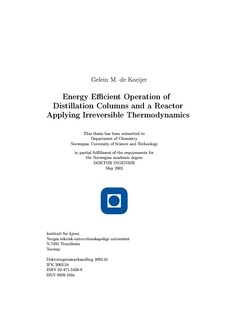| dc.contributor.author | De Koeijer, Gelein M. | nb_NO |
| dc.date.accessioned | 2014-12-19T13:20:39Z | |
| dc.date.available | 2014-12-19T13:20:39Z | |
| dc.date.created | 2002-05-22 | nb_NO |
| dc.date.issued | 2002 | nb_NO |
| dc.identifier | 125512 | nb_NO |
| dc.identifier.isbn | 82-471-5436-6 | nb_NO |
| dc.identifier.uri | http://hdl.handle.net/11250/247464 | |
| dc.description.abstract | In this thesis the entropy production rate of diabatic distillation columns and a SO2 converter were minimised. This is the same as maximising the second law energy efficiency of the systems. The development of chemical industry can be made more sustainable by knowing this minimum. We found that the entropy production rate of distillation could be reduced up to 50%. In order to achieve this reduction, heat exchangers were added on each tray. The characteristics of an optimum distillation column were presented. Furthermore, the entropy production rate of a SO2 converter was reduced with 16.7% by altering the heights of catalytic beds, transfer areas of heat exchangers, and temperature differences over heat exchangers. These reductions show that there is still a large improvement potential in chemical industry. By applying the improved operations the world oil production can be reduced in the order of magnitude of 1%. A similar reduction in the emission of the greenhouse gas CO2 can be expected.
For deriving the entropy production rate in a systematic manner the theory of irreversible thermodynamics was useful. A simpler and a more complicated equation for the entropy production rate of distillation were derived. The simpler equation used only one force-flux product. It was suitable for minimisation of the entropy production rate of columns with the assumption of equilibrium between the outlets on each tray. The more complicated equation was able to describe satisfactorily the entropy production rate of an experimental column that separated the non-ideal mixture water-ethanol. It was next used to derive an extended set of transport equations for distillation, that includes the interface and the Soret effect (or thermal diffusion). Finally, irreversible thermodynamics was used to describe the contributions to the entropy production rate of heat transfer in heat exchangers. This contribution had a significant impact on the results of the minimisations.
A method that can provide the chemical industry the thermodynamically optimum operation of distillation columns and reactors was constructed and exemplified. Once the system and its boundaries are determined, the objective function with its constraints and variables are set up. Several suitable minimisation procedures exist. Finally, the design of the thermodynamically optimum system is obtained from the state of minimum entropy production rate. | nb_NO |
| dc.language | eng | nb_NO |
| dc.publisher | Fakultet for naturvitenskap og teknologi | nb_NO |
| dc.relation.ispartofseries | Dr. ingeniøravhandling, 0809-103X; 2002:41 | nb_NO |
| dc.relation.haspart | De Koeijer, Gelein; Kjelstrup, Signe. Minimising Entropy Production Rate in Binary Tray Distillation. International Journal of Applied Thermodynamics. 3(3): 105-110, 2000. | nb_NO |
| dc.relation.haspart | De Koeijer, Gelein; Kjelstrup, Signe; Salamon, Peter; Siragusa, Gino; Schaller, Markus; Hoffmann, Karl Heinz. Comparison of Entropy Production Rate Minimization Methods for Binary Diabatic Distillation. Ind. Eng. Chem. Res.. 41(23): 5826-5834, 2002. | nb_NO |
| dc.relation.haspart | De Koeijer, Gelein; Rivero, Richardo. Entropy production and exergy loss in experimental distillation columns. Chemical Engineering Science. 58(8): 1587-1597, 2003. | nb_NO |
| dc.relation.haspart | De Koeijer, Gelein; Røsjorde, Audun; Kjelstrup, Signe. The Role of Heat Exchangers in Optimum Diabatic Distillation Columns. Energy. 29(12-15): 2425-2440, 2004. | nb_NO |
| dc.relation.haspart | Kjelstrup, Signe; De Koeijer, Gelein. Transport equations for distillation of ethanol and water from the entropy production rate. Chemical Engineering Science. 58(7): 1147-1161, 2003. | nb_NO |
| dc.subject | Chemistry | en_GB |
| dc.subject | NATURAL SCIENCES: Chemistry | en_GB |
| dc.title | Energy efficient operation of distillation columns and a reactor applying irreversible thermodynamics | nb_NO |
| dc.type | Doctoral thesis | nb_NO |
| dc.source.pagenumber | 156 | nb_NO |
| dc.contributor.department | Norges teknisk-naturvitenskapelige universitet, Fakultet for naturvitenskap og teknologi, Institutt for kjemi | nb_NO |
| dc.description.degree | dr.ing. | nb_NO |
| dc.description.degree | dr.ing. | en_GB |
